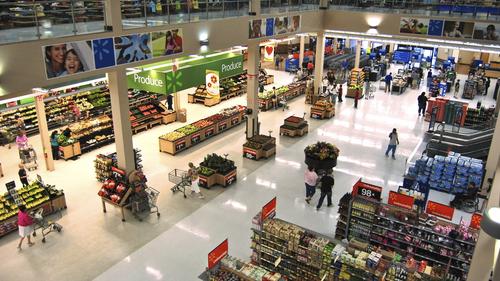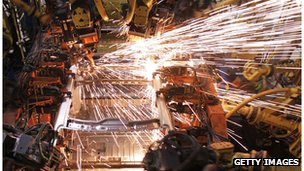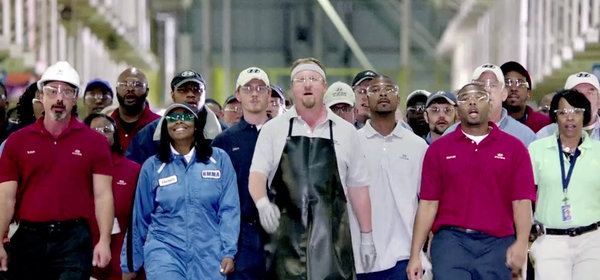
The Reshoring Initiative is partnering with Walmart to help retailers and suppliers manufacture more of their consumer products in the US. Continue reading Walmart Partners with Reshoring Initiative as Made in USA Gets Real

The Reshoring Initiative is partnering with Walmart to help retailers and suppliers manufacture more of their consumer products in the US. Continue reading Walmart Partners with Reshoring Initiative as Made in USA Gets Real

ORLANDO, FLA. — Wal-Mart Stores Inc. is looking to boost the number of domestic suppliers as part of its 10-year, $250 billion investment program, according to the retail giant’s head of U.S. manufacturing. Continue reading Wal-Mart: We want to #BuyAmerican!
Reshoring is the hottest trend in U.S. manufacturing. According to a recent study by Boston Consulting Group, 54 percent of all United States companies over $1 billion in revenues are planning or considering bringing at least some of their manufacturing back to the U.S. Continue reading What Happens When You Decide to Leave China?
Sep 20, 2013 (The Gazette (Menafn – Colorado Springs – McClatchy-Tribune Information Services via COMTEX) —
Maxx Sunglasses hopes to use 3-D printing to write a new chapter in its business plan.
The Monument-based sunglass maker bought a high-capacity 3-D printer last month for 70,000, and is using it to make prototypes of the glasses and other merchandise with logos and team colors from professional baseball and football teams and college football teams.
The company plans to spend 500,000 over the next three years to buy enough 3-D printing equipment to bring production of its sunglasses to Monument from contract manufacturers it uses in Taiwan. The company also use the printers to manufacture other products it plans to add to its lineup, such as gift items and chess sets.
Three-dimensional printers aren’t printers like the ones most consumers use with their home computers. Using specs created on computers and sent to the printer, the devices build objects with plastic or powdered material held together with a super-glue-like resin, one thin layer at a time, with heads equipped with small jets similar to inkjet printers.
The machine Maxx uses is the size of a washer and dryer set side-by-side, and it can create sunglasses, chess sets and other objects in just a few hours.
“Three-D printing gives us so many options that it is an exciting thing for business. It reminds me of the beginning of the computer age or when we first began using the Internet,” said Rick Milner, CEO, co-founder and owner of Maxx. “Our whole idea with 3-D printing is it gives us more access to other product lines for the licenses we already hold. It will allow us to move from sunglasses to other gift items, like a chess set, and allow us to partner with artists and entrepreneurs who have ideas for licensed products.”
Already, the 3-D printer that Maxx bought has reduced the time the company spends producing prototypes from a month to two or three days, since the company no longer has to send designs to its manufacturers in Taiwan and wait for them to be made and shipped back to Monument, Milner said. That will allow Maxx to display potential products at annual trade shows and take orders from retailers, television shopping networks, online sales sites and the teams for which it holds licenses, he said.
Maxx plans to add at least 25 people to its 35 year-round employees once it begins manufacturing its own products, Milner said. The company has formed a separate division for its 3-D printing operations, called Maxx 3D, that will do 3-D printing, design and prototyping.
Milner and his wife and business co-owner, Nancy, couple got into the sunglass business in 2000 after owning other companies, including a vehicle window-tinting business that grew too quickly and failed. They initially sold sunglasses from trailers parked on street corners in the Springs and other locations before switching to a distribution model of selling through retailers, websites and television shopping networks.
Maxx expects to hit 10 million in sales this year, largely from licensing deals: one signed in 2011 with Major League Baseball; one signed last year with Collegiate Licensing Co. for 43 college football teams; and one signed in June with the National Football League. Since landing the first licensing deal, the company’s sales have more than doubled, and licensed sunglasses — which are made in a team’s colors and have a small medallion on the side with the team’s logo — are expected to overtake its primary line of sunglasses by the end of next year, Rick Milner said.
–
Contact Wayne Heilman: 636-0234 Twitter @wayneheilman
Facebook Wayne Heilman
___ (c)2013 The Gazette (Colorado Springs, Colo.) Visit The Gazette (Colorado
Springs, Colo.) at www.gazette.com Distributed by MCT Information Services
Copyright (C) 2013, The Gazette (Colorado Springs, Colo.)

Written by: BBC North America editor, Mark Mardell
Drew Greenblatt is an enthusiast: proud of his company, Marlin Steel, and proud of the factory floor packed with state-of-the-art equipment.
I watch, fascinated, as a little white robot squeezes out a wire, putting kinks and bends in it as it emerges.
Then it hands it over to a slightly larger yellow robot, which holds it steady for a twist in the end before turning it over for another twist at the other end.
Oddly, I find this cutting-edge equipment rather cute and cartoonish.
The question is whether this endearing duo are merely the remnants of America’s industrial past or the sort of equipment that will make the USA world-beaters once again.
The factory floor space at Marlin Steel is being doubled and there is no doubt the company is doing well, prospering even, during the bad years. Continue reading What Does the Future Hold for American Manufacturing?

![]() by DAN CHARLES February 22, 2012
by DAN CHARLES February 22, 2012
If you happen to notice sometime later this year that you’re suddenly paying a lot more for orange juice, you can blame America’s food safety authorities. The U.S. Food and Drug Administration, after several weeks of deliberation, has blocked imports of frozen, concentrated orange juice from Brazil, probably for the next 18 months or so, even though the agency says the juice is perfectly safe.
The FDA’s explanation is that its hands are legally tied. Its tests show that practically all concentrated juice from Brazil currently contains traces of the fungicide carbendazim, first detected in December by Coca-Cola, maker of Minute Maid juices. The amounts are small — so small that the U.S. Environmental Protection Agency says no consumers should be concerned.
The problem is, carbendazim has not been used on oranges in the U.S. in recent years, and the legal permission to use it on that crop has lapsed. As a result, there’s not a legal “tolerance” for residues of this pesticide in orange products. Continue reading FDA Says Brazil’s Orange Juice Is Safe, But Still Illegal
 By Howard Wial @CNNMoney February 23, 2012: 5:34 AM ET
By Howard Wial @CNNMoney February 23, 2012: 5:34 AM ET
Howard Wial is a fellow for the Brookings Institution Metropolitan Policy Program.
At first glance, manufacturing jobs would appear to be a dying breed.
The United States lost 6 million manufacturing jobs between early 2001 and late 2009. And despite small gains during the last two years, the trend in manufacturing employment for the last 30 years has been downward.
That has led some to argue that long-term job loss in the industry is inevitable. But our research shows otherwise.
There are two common versions of the “inevitability” argument. One holds that U.S. manufacturing wages are too high to be internationally competitive. The other maintains that manufacturing job losses are the result of productivity growth. Both arguments are wrong. Continue reading How to Save U.S. Manufacturing Jobs
Brian Sozzi, Contributor 2/16/2012
The grand theme I want to put on the table is the concept of onshoring, sometimes called reshoring, which is the bringing back of U.S. jobs from overseas supply chains.
U.S. businesses have started to realize that while workers in far away lands garner miniscule wages compared to their U.S. counterparts, having operations outside of the country can be a strategic disadvantage. The speed and structure in which information is consumed has caused U.S. consumers to demand top quality products and to want to buy them whenever they please.
Having a manufacturing plant domestically aids in the quicker movement of goods from design table to sales floor. Furniture maker Ethan Allen is great example of a manufacturer producing most of its products in the U.S. and doing customization for clients, setting itself apart from price-point focused competitors.
Corporate managers are simply getting over their infatuation with cheap international labor and analyzing the total costs of doing business in the U.S. compared to say, China or India.
There is a dollop of icing on the cake here as well. The topic of focusing on onshoring to boost employment levels seems to be an area of agreement between bickering Republicans and Democrats. Republican presidential hopeful Rick Santorum, for example, wants to zero out the U.S. corporate tax for manufacturers.
Anytime the major political parties agree on anything, even the slight thing, it’s cause to sit up and take notice from an investment standpoint. The Donkeys and Elephants may be a little apart on how to precisely shepherd along the corporate onshoring interest, but at least they are talking the same language. It’s high time they do find common ground if the following is to be reversed:
I have read a fair number of columns bantering about onshoring. Is it overhyped? Do we really need more jobs in the service sector U.S. economy? The debates are almost endless. Unfortunately, though, I have failed to stumble upon investment strategies to profit from onshoring, which has already begun to a certain extent, and could likely gain steam in the years ahead.
Buy-and-hold investors, this should be right in your wheelhouse: a highly probable future event to build positions around in companies with durable competitive advantages.
A few names that come to mind:

BLUE-COLLAR workers in fields like manufacturing — particularly when they make products on American soil — are again becoming a favorite subject for white-collar workers on Madison Avenue.
The trend was born of the economic worries that followed the financial crisis in 2008. Recently, it is gaining steam — appropriate, since the ads often use blasts of steam to signal something is being built — with proposals in Washington to offer incentives to encourage the location or relocation of factories in the United States.
“We continue to see very heavy emotional response to anything that would leverage against the bad economy,” said Robert Passikoff, president at Brand Keys, a brand and customer-loyalty consulting company in New York. Continue reading This Column Was 100% Made in America
MILWAUKEE (Reuters) – President Barack Obama kept up his attack on Chinese trade practices during a campaign-style visit on Wednesday to a Midwest factory, where his call to bring jobs back home was intended to resonate with voters in an election year.
The day after meeting China’s leader-in-waiting, Vice President Xi Jinping, at the White House, Obama cited America’s chief rival a number of times in a speech to promote the potential of “insourcing” jobs back to America from overseas.
“I will not stand by when our competitors don’t play by the rules,” he told workers at Master Lock, a company he lauded in his State of the Union address last month for having moved back about 100 union jobs from China since mid-2010.
“That’s why I directed my administration to create a Trade Enforcement Unit with one job: investigating unfair trade practices in countries like China,” he said in prepared remarks.
Obama took a firm line over trade on Tuesday during his Oval Office meeting with Xi, who is in line to assume the Chinese presidency in March 2013.
This tough stance should appeal to voters in election battleground states like Wisconsin, where Beijing is often blamed for killing American jobs.
Republican presidential hopeful Mitt Romney, a former private equity executive, accuses Obama of being too soft on China and lacking the executive or other leadership experience to steer the U.S. economy toward lasting recovery.
Master Lock, a unit of Fortune Brands Home & Security, is the world’s largest manufacturer of padlocks and related products to secure homes, cars and bicycles. Its story is a positive one for Obama, who must tout his economic leadership to secure another White House term.
The firm says its Milwaukee plant is running at full capacity for the first time in 15 years – an example the White House is eager to replicate as the November 6 election nears.
“They’re deciding that if the cost of doing business here is no longer much different than the cost of doing business in countries like China, they’d rather place their bets on America,” said Obama.
It was his first stop in a three day campaign-style swing when the Democrat will raise funds in California and stop at aircraft manufacturer Boeing in Washington state.
How to cope with a rising China – and compete against cheap Chinese exports – is one of the toughest challenges for Obama to navigate as the election approaches, particularly as opinion polls showing rising U.S. voter frustration with the Asian economic powerhouse.
(Reporting By Laura MacInnis; Editing by Peter Cooney and Cynthia Osterman)
You must be logged in to post a comment.